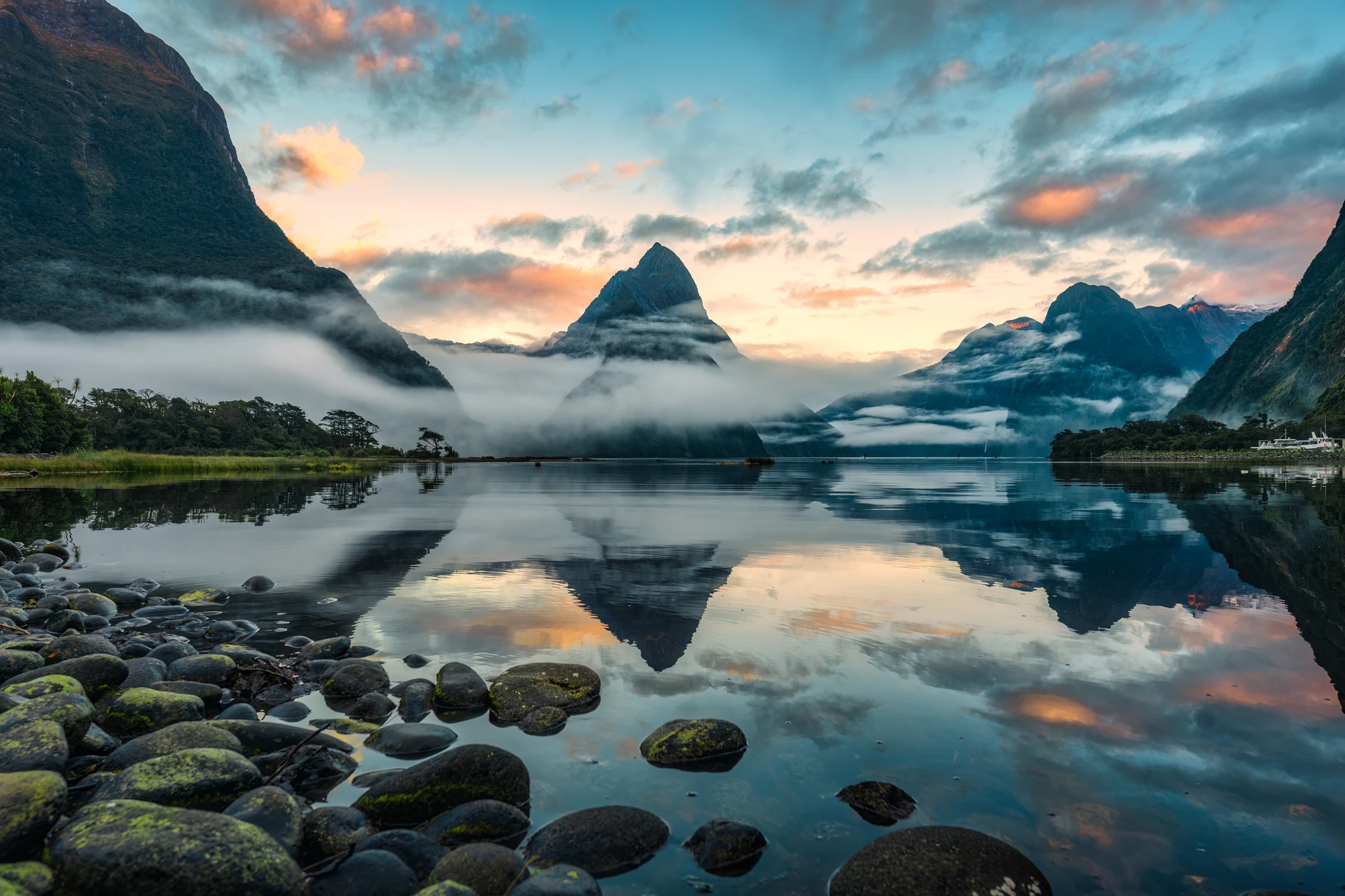Piopiotahi at First Light: Milford Sound’s Quiet, Thunderous Pull
A morning on the water, a lifetime of perspective: how Piopiotahi shapes the South Island
Photo by Unknown
Shutterstock (ID: 2486135973)
The boat slips off the jetty before sunrise and the fiord inhales. Low clouds shear across the glassy water; Mitre Peak—its shoulders still in shadow—rises as if grown overnight from the sea. A row of waterfalls unspools along the cliff faces, each ribbon urgent with last night’s rain. In the hush between engines and gulls, Milford Sound feels less like a destination and more like an old island of weather coaxing visitors into a slow, observant silence.
Trail Wisdom
Dress for downpours
Milford can rain at any hour; bring a waterproof shell and quick-drying layers to stay comfortable on cruises or hikes.
Book early for summer
December–February fills fast—reserve cruises, scenic flights, or kayak tours well in advance to secure morning departures.
Bring insect protection
Sandflies are common in sheltered spots—use a head net and DEET-based repellent to keep them from ruining a picnic.
Mind the wildlife distance
Seals and birds are protected—keep at least several meters away and never attempt to feed or touch wildlife.
Local Knowledge
Hidden Gems
- •The Chasm—short walk to dramatic carved rock and thunderous water
- •Lake Marian Track—less crowded alpine lake with reflective views
Wildlife
New Zealand fur seal, bottlenose dolphin
Conservation Note
Operators follow strict wildlife protocols and many local groups work to control predators and preserve native forest—travelers should follow leave-no-trace practices.
Milford Sound is part of Te Wahipounamu, a UNESCO World Heritage area; its Māori name Piopiotahi reflects ancestral stories tied to the land and sea.
Seasonal Guide
spring
Best for: wildflower displays, cascading waterfalls, quieter trails
Challenges: variable weather, cold snaps, limited daylight early season
Spring brings explosive waterfalls and fewer crowds, but expect quick weather shifts and chilly mornings.
summer
Best for: calmer water, long daylight, easy access to guided activities
Challenges: crowds, higher prices, sun exposure
Summer offers the most predictable operating schedules and longer days—book ahead and plan early starts.
fall
Best for: dramatic light, fewer tourists, crisp air for flights
Challenges: shortening daylight, variable water conditions, cooler nights
Autumn delivers crisp air and vibrant skies; mornings can be particularly photogenic for flights and cruises.
winter
Best for: snow-capped peaks, moody seascapes, clear air after storms
Challenges: short days, possible road closures, colder water temperatures
Winter yields dramatic contrasts—snow on the ridges and fewer visitors—though accessibility can be affected by storms.
Photographer's Notes
What to Bring
Waterproof shell jacketEssential
Protects against frequent rain and wind on the water and trails.
Mid-range zoom lens (70-200mm)
Captures wildlife and distant waterfalls without getting too close.
Sturdy, waterproof footwearEssential
Keeps you steady on wet docks, muddy trails and rocky viewpoints.
Small dry bagEssential
Protects electronics and layers during boat trips and while kayaking.
Common Questions
How do I get to Milford Sound?
Most visitors drive from Te Anau (about 2–3 hours) along State Highway 94; guided coach transfers are also available from Queenstown and Te Anau.
Do I need to book a cruise in advance?
In summer and holidays yes—book morning cruises weeks ahead; shoulder season is more flexible but check daily schedules.
Can I kayak in Milford Sound if I’m a beginner?
Yes—guided kayak tours cater to beginners, providing instruction, safety gear and a guide to manage conditions.
Is there cell service in Milford Sound?
Mobile coverage is limited; don’t rely on cell service for navigation or emergency contact—download maps and tell someone your plans.
Are there accommodations at Milford Sound?
There are limited lodges and a small DOC campsite; many visitors base in Te Anau or use day trips from Queenstown.
What wildlife should I expect to see?
Common sightings include New Zealand fur seals, bottlenose dolphins, and a variety of seabirds; rare sightings might include the Fiordland crested penguin.
What to Pack
Waterproof jacket (stays dry in constant rain), mid-range zoom lens (capture wildlife at a distance), sturdy waterproof shoes (traction on wet terrain), dry bag (protect electronics on the water)
Did You Know
Milford Sound is one of the wettest places in the world, averaging roughly 6,000 mm (about 240 inches) of rainfall per year, which feeds its many permanent waterfalls.
Quick Travel Tips
1) Drive the Milford Road early to avoid afternoon traffic; 2) Book cruises and flights in summer weeks ahead; 3) Carry cash for small purchases in remote areas; 4) Check DOC and road updates for closures before traveling.
Local Flavor
Piopiotahi is part of Fiordland’s small community network—base in Te Anau for local smoked salmon, venison dishes and visitor-run conservation cafes; learn local Māori place names and history from guides who incorporate Te Reo and oral stories.
Logistics Snapshot
Getting there: 2–3 hour drive from Te Anau; Book: cruises and flights recommended in peak season; Essentials: waterproof layers, insect repellent, camera with zoom; Time needed: half-day for main cruise, multi-day for Milford Track.
Sustainability Note
Choose operators accredited for low-impact practices, avoid feeding or approaching wildlife, and use marked tracks—support local conservation levies where available.

